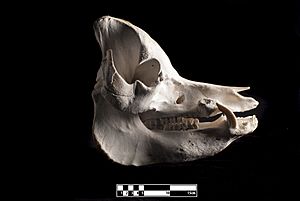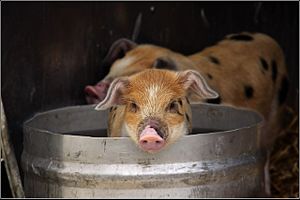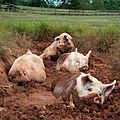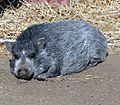Pig facts for kids
Quick facts for kids Pig |
|
|---|---|
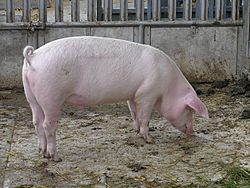 |
|
| A domestic pig on an organic farm in Switzerland |
|
| Conservation status | |
| Scientific classification | |
| Kingdom: | |
| Phylum: | |
| Class: | |
| Order: | |
| Family: | |
| Genus: |
Sus
|
| Species: | |
Pigs are mammals in the genus Sus. They include the domestic pig and its ancestor, the common Eurasian wild boar (Sus scrofa), and other species. Pigs are in the Suidae family of even-toed ungulates.
Related, but outside the genus, are the babirusa and the warthog. Pigs, like all suids, are native to the Old World. Juvenile pigs are known as piglets. Pigs are omnivores and are highly social and intelligent animals.
Domestic pigs are eaten as food called pork or bacon. The Jewish and Muslim religions, and some Christian denominations, believe eating pork is wrong. It is, however quite healthy food for humans. Pig farmers take care that the animals do not get diseases or parasites which might harm humans.
Domestic pigs are often pink, but small pigs kept as pets (pot-bellied pigs) are often other colors. Pigs often roll in mud to protect themselves from sunlight. Many people think that pigs are dirty and smell. In fact, they roll around in the mud to keep bugs and ticks away from their skin. This also helps to keep their skin moist and lower their body temperature on hot days. They are omnivores, which means they eat anything that comes in their way.
Pigs are intelligent animals. They can be taught to dance, hunt for truffles, race, pull carts and sniff out landmines. They can even be taught to play video games.
Contents
Description and behaviour
A typical pig has a large head with a long snout that is strengthened by a special prenasal bone and by a disk of cartilage at the tip. The snout is used to dig into the soil to find food and is a very acute sense organ. There are four hoofed toes on each foot, with the two larger central toes bearing most of the weight, but the outer two also being used in soft ground.
The dental formula of adult pigs is 3.1.4.33.1.4.3, giving a total of 44 teeth. The rear teeth are adapted for crushing. In the male, the canine teeth form tusks, which grow continuously and are sharpened by constantly being ground against each other.
Occasionally, captive mother pigs may savage their own piglets, often if they become severely stressed. Some attacks on newborn piglets are non-fatal. Others may cause the death of the piglets and sometimes, the mother may eat the piglets. It is estimated that 50% of piglet fatalities are due to the mother attacking, or unintentionally crushing, the newborn pre-weaned animals.
Distribution and evolution
With around 1 billion individuals alive at any time, the domestic pig is one of the most numerous large mammals on the planet.
The ancestor of the domestic pig is the wild boar, which is one of the most numerous and widespread large mammals. Its many subspecies are native to all but the harshest climates of continental Eurasia and its islands and Africa as well, from Ireland and India to Japan and north to Siberia.
Long isolated from other pigs on the many islands of Indonesia, Malaysia, and the Philippines, pigs have evolved into many different species, including wild boar, bearded pigs, and warty pigs. Humans have introduced pigs into Australia, North and South America, and numerous islands, either accidentally as escaped domestic pigs which have gone feral, or as wild boar.
Habitat and reproduction
The wild pig (Sus scrofa) can take advantage of any forage resources. Therefore, it can live in virtually any productive habitat that can provide enough water to sustain large mammals such as pigs. If there is increased foraging of wild pigs in certain areas, it can cause a nutritional shortage which can cause the pig population to decrease. If the nutritional state returns to normal, the pig population will most likely rise due to the pigs' naturally increased reproduction rate.
Diet and foraging
Pigs are omnivores, which means that they consume both plants and animals. In the wild, they are foraging animals, primarily eating leaves, roots, fruits, and flowers, in addition to some insects and fish. As livestock, pigs are fed mostly corn and soybean meal with a mixture of vitamins and minerals added to the diet. Traditionally, they were raised on dairy farms and called "mortgage lifters", due to their ability to use the excess milk as well as whey from cheese and butter making combined with pasture. Older pigs will consume three to five gallons of water per day. When kept as pets, the optimal healthy diet consists mainly of a balanced diet of raw vegetables, although some may give their pigs conventional mini pig pellet feed.
Relationship with humans
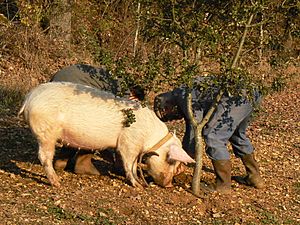
Domesticated pigs, especially miniature breeds, are commonly kept as pets. Domestic pigs are raised commercially as livestock; materials that are garnered include their meat (known as pork), leather, and their bristly hairs which are used to make brushes. Because of their foraging abilities and excellent sense of smell, they are used to find truffles in many European countries. Both wild and feral pigs are commonly hunted.
The relatively short, stiff, coarse hairs of the pig are called bristles, and were once so commonly used in paintbrushes that in 1946 the Australian Government launched Operation Pig Bristle. In May 1946, in response to a shortage of pig bristles for paintbrushes to paint houses in the post-World War II construction boom, the Royal Australian Air Force (RAAF) flew in 28 short tons of pig bristles from China, their only commercially available source at the time.
Care
Pigs need a warm, clean area under a roof to sleep, and they should not be crowded. They need to be checked for sickness regularly. Stress can make them get sick with rabies more easily.
Pigs need lots of water. Over half their body weight is made up of water. Pigs should be given all the feed they will eat, which is usually 4 to 5 pounds a day for adult pigs. Corn is a good food for pigs, but they should also have protein supplements as well.
Where they are found
Pigs are often found on farms throughout the world and can be popular pets. A new breed of micro pigs has become very popular but often piglets are misold as micro pigs and then grow to be too big. In places pigs are mass farmed to produce the best animal for meat. These meat farms are often overcrowded with pigs and conditions are really bad.You can find pigs in farms. Some pigs are wild and some are live on a farm.
Images for kids
-
Bronze pig sculpture, Zhou dynasty
-
A Large White, a breed commonly used in meat production
See also
 In Spanish: Sus scrofa domestica para niños
In Spanish: Sus scrofa domestica para niños


